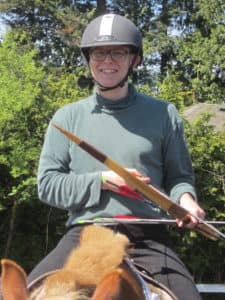
Last week I talked about the importance of swordsmen learning dagger techniques, and I promised I'd explain how to integrate training the dagger material with the longsword material. This needs to be done at the level of syllabus design, as well as within specific training sessions or classes. Let's start with the syllabus.
NOTE: In this post I'll be referring to lots and lots of specific drills from my syllabus. It would get ridiculously long if I wrote them all out, or even embedded the relevant video at every step. But you can find all of this material online on video on the Armizare syllabus page.
My Armizare syllabus is divided into seven levels, the first four of which are considered ‘basic'. If we take a look at the first couple of levels you'll see that the dagger content is spread out, as is the sword. Level one, for instance, covers the following:
Mechanics and Conditioning:
- Weight distribution on the feet
- Tailbone Alignment
- The basic guard position
- The guard positions
- Standing Step drill (aka push-hands)
- Basic falling, solo
- Stick avoidance drill
- Understanding of safe training, control, and School etiquette
Unarmed:
- Fiore footwork: 4 steps: accrescere, discrescere, passare, tornare; 3 turns: volta stabile, meza volta, tutta volta
- Four unarmed poste: longa, dente de zenghiaro, frontale, porta di ferro
Dagger:
- The meaning of the terms remedy, counter-remedy and counter-counter-remedy
- 4 lines of attack: mandritto, fendente, roverso, sotto.
- First remedy master (against mandritto or fendente)First 7 plays of the First Master
- Roverso disarm (third master, from Pisani-Dossi MS), from Third remedy master (against roverso or fendente)
- Fendente disarm (fourth master)
- Sottano disarm (ninth master)
Longsword
- Five of The 12 guards: Tutta porta di ferro, posta di donna (both sides), posta longa, posta frontale, dente di zenghiaro
- Two of the Seven Blows: Fendente, Sottano
- Sword handling drill up, down, around, around.
- Cutting drill, part one only.
- The salute
- First drill
- Second drill
As you can probably see, there is a minimum of learning large chunks of data (such as all seven blows of the sword), and an emphasis on teaching just enough new elements that the student can start working on applications. So they learn one blow of the dagger, and one defence against it, then the same defence against another blow, then another and another, before they learn all four blows of the dagger as a set to memorise. They also have sword handling drills, and two full-length sword drills. The difficulties they face learning the sword drills will make the dagger material in the next level very welcome; it will solve a problem for them.
In Level Two, they will find:
Mechanics and Conditioning
- Forearm conditioning: Wrist and Forearm Exercises
- Forearm massage: Self Massage
- Basic Breathing exercises
- Guard position analysis with pressure
- Volta stabile and pass with pressure
- The footwork combinations: 1) accressere fora di strada, passare alla traversa, 2) accressere, 3 passi, with tutta volta.
- Able to competently warm up self
Dagger
- The Nine Masters One thing from each of the Nine Remedy Masters
- Dagger disarm flowdrill
- The 5 things: disarm, strike, lock, break, takedown
- Five things from four lines
Longsword
- All of the Blows, including the Mezani, and the 5 Punte
- All of The 12 guards
- Sword handling drill 3: six grips
- Exchange of thrust
- Breaking the thrust
- Four corners drill
- First two plays of sword in one hand
Now that the base has been laid in level one, it's quite easy to build on it in level two. Incidentally, I'm sure that some Fiore scholars will be horrified to see the lack of abrazare so far; that is coming in the next level, at which point, as with the dagger material, it will actively solve a problem for the students, rather than be something they have to plod through to get to the shiny sword.
At this stage, the students have a complete set of basic techniques for the dagger; all nine remedy masters, and all five things that Fiore tells us we need to know (on f9v of the Getty Ms).
This pattern of interleaving dagger and sword (as well as abrazare, spear, and so on) continues throughout the syllabus, though the dagger material is essentially complete by level four. It would be remiss of me not to mention the section of the manuscript that explicitly ties the dagger and sword sections together: the defences of the dagger against a sword attack, and the defences of the sword in the scabbard against a dagger attack. We do cover these in the syllabus, but much later than you would otherwise expect, because the defence of the dagger against the sword requires a) both partners to be able to attack safely with the sword and b) both partners to be able to do a pretty tricky technique. They will usually get there in level four when learning the Syllabus Form, which begins with the defence of the sword against the dagger.
Integrating dagger into the class:
In a well-taught class there is a coherent reason for including every item that is taught. It could simply be ‘you're working on this level, and you need to know this new thing'. That is, if you like, the most basic level of teaching: filling gaps in the students knowledge. For this, you must have a syllabus, and the students must be able to track their progress along the path laid out in the syllabus.
At the next level, there is teaching a single idea across different contexts. For example, in our second drill with the longsword, we have a ligadura mezana at step three (the counter-remedy). This first occurs at time 0.13 in this video.
https://youtu.be/SUw7JSKgFAI
The counter-counter-remedy first occurs at 0.20, and is the 15th play of the zogho stretto (as referred to in last week's post). Most students find this particularly difficult against an enthusiastically applied ligadura. If I'll be teaching second drill, I'll adjust the whole structure of the class to lead up to it. Let me take you through what that would look like, and run you through the usual structure for a 90 minute evening class in my salles at the same time:
Salute
Warm-up (10 min or so). This will emphasise shoulder mobility, to prepare for the locks.
Four guards drill, other footwork drills: 5-10 minutes. Possibly include the standing step drill, and work the ligadura and its counter into that.
Dagger (10-30 minutes): starting with first play first master (disarm), then on to the third and fourth plays (ligadura mezana and its counter). This will be taught from scratch, or revised, depending on the level of the class, and may go on to tactical applications, or executing the plays in more complex environments (such as the dagger disarm flowdrill) if the students are ready for it.
Longsword (rest of the time; usually 30-40 minutes):
Sword handling first: sword handling drills, and/or cutting drill, and/or farfalla di ferro. This may be 5 minutes if sword handling is not usually a critical point of failure in the target (in this example, second drill), or 15 or 20 minutes if it is (e.g. when teaching the punta falsa).
Then second drill, step by step, for the remainder of the class. Assuming that the class is ready for the whole drill, then steps one and two should be pretty solid already, so most of the time will go on working on steps three (ligadura) and four (its counter).
So in this example, we are using the dagger plays as a lead-in to teaching the same basic actions with the sword.
At the next level of teaching, once these basic technical issues are fundamentally resolved, then we can start using the dagger material for training tactical principles, and attributes such as speed, timing, and grounding. For instance, working on counter-remedies. One major difference between knightly combat and modern self defence is that knightly combat is not usually concerned with self defence. It's a military art, for soldiers whose main job is to kill people for social or political reasons. So we have multiple examples of the dagger attacker *overcoming the defender*. By modern standards, this is murder, plain and simple, especially as that defender is often unarmed! (This is one of the examples I use to hammer home to beginners the idea that this is nothing like modern, politically correct, or self-defence-oriented martial arts.) Teaching a student to attack, flow around the defender's response, and strike (many times) is easier with a dagger than a sword. The basic tactical structure of any fencing sequence can be reproduced with the dagger, so you can teach the structure with the easier-to-control weapon, and then move on to applying the same principles with the longsword.
I should point out at this stage that it is *perfectly correct* to simply start at the beginning of the manuscript and work your way through from abrazare, to dagger, to sword, to armour, to polearms, and on to mounted combat. It works just fine. But Fiore certainly did not write his book as a training manual for 21st century computer programmers, nurses, lorry drivers or university students. He wrote it as a complete representation of his art, for a 15th century nobleman who was also an experienced warrior. It should come as no surprise that the ideal pedagogical structure for the average student that comes to my classes is a bit different to the ordering that Fiore gives us.
Let me finish off by saying that the way I solve this problem is not the only way; it's just what seems to work best in my experience. And it's worth mentioning that the exact approach I take in any class is actually student-led; I almost invariably ask the students present in my classes what they are interested in learning, and teach them that. For instance, I'll be in Auckland, New Zealand, teaching a seminar in November 4th and 5th (you can find out the details here: if you're in the neighbourhood do come; I'd love to see you there). The organisers have specifically requested that I spend a day on the dagger, and then a day on the sword; that's fine by me!
Some useful resources:
The Syllabus wiki: http://www.swordschool.com/wiki/index.php/Fiore_basic_syllabus
You could check out The Medieval Dagger book. You can even get it in German!
And yes, I even have a course on it. But before you dash off to buy it, remember that I’ll be launching it with a hefty discount to my email list in a week or so, so it might be a good idea to sign up below in anticipation of that happy event.





